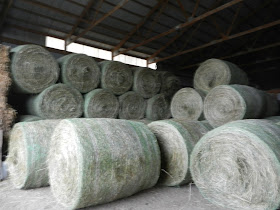 |
| Buffer Zone Hay for Equines |
It's that time. It is hot and sunny and dry.
The perfect time to make hay. This year is a first for us as we've made our own organic hay. In years past , due to limited land we have bought all our hay except for the horse hay which we make from the roadsides and buffer zones. But since we have less cows than ever before we have more pasture to turn into hay. Even though we had to hire someone to bale the hay we still saved a large amount of money. Now back to Buffer Zones.
 |
| A field full of round bales extends all the way to the tree line |
A buffer zone is the land between certified organic land and non-certified organic land. Usually about 25 feet wide and as long as we want, it is hay made from wild grasses and other vegetation. We cannot under the NOP (National Organic Program) feed it to our cows, beef and swine which we sell to consumers but we can feed buffer made hay to my horse and donkey.
 |
| First round bale goes on the wagon. It's a trick to keep it all balanced |
Since we have no plans to consume them...yet.
For the convienence of the Midlife Farmwife, the buffer hay is done up as small square bales. It would take Ennis and Doolin ages to go through a round bale anyway. The cows and pigs will get the big round bales.
I love the way the round bales look.
 |
| 62 round bales divided by 5 bales per load equals...numerous trips! |
Like big green marshmellows dotting the prairie.
Like shredded wheat for the organically focused Green Giant
Like a kalidescope of grass and alfalfa and wild flowers and the unsung hero-weeds.
Like get on with it will ya?!?
 |
| Last of the previous years hay on left, our own round bales next to them Pallets used to keep hay dry and off the ground |
Yesterday, with rain on the way, we had to get the big round bales in the barn. 62 of them. I pulled the wagon out into the field and Keith loaded it with the tractor. Since the hay rack will only hold 5 big bales at a time the whole process took a few hours.
As we worked the clouds began rolling in, darker and darker.
 |
| Hmmm. Is that lightening in the distance? |
 |
| View of our farm looking West. Barn on left, machine shed in middle and house to right of that. Dark rolling clouds above. |
 |
| Stacking round bales takes skill. Which is why Keith does it, not me. |
There are many things that give one a sense of accomplishment on the farm but none quite like the feeling of a barn full of hay for the next year. Well, nearly full.




Still a few fields here that are yet to be cut. Your system is pretty much the same as here, although more and more people are wrapping their round bales in plastic and leaving them outside as semi-silage.
ReplyDeleteWow it was wonderful to see your pictures. We see those large roll hay bales across the farms where I live in England so I know how big they are. The weather seems have gone mad right round the world these last few years.
ReplyDeleteGlad to know things are going well with you and your family, Donna.
I was admiring how few volunteer plants were in your hay fields yesterday. It makes you wonder why GMOs are needed when organic does so well.
ReplyDeleteYou may thank me for the rain or you may not....I watered all my gardens down here in Metamora and not two minutes later the storms rolled in. ;-)
ReplyDeleteSorry the hay got wet! Sorry Keith got wet!
Nice to see all the bales in your barn and come winter the donkey and horse will be loving all that good yummy hay.